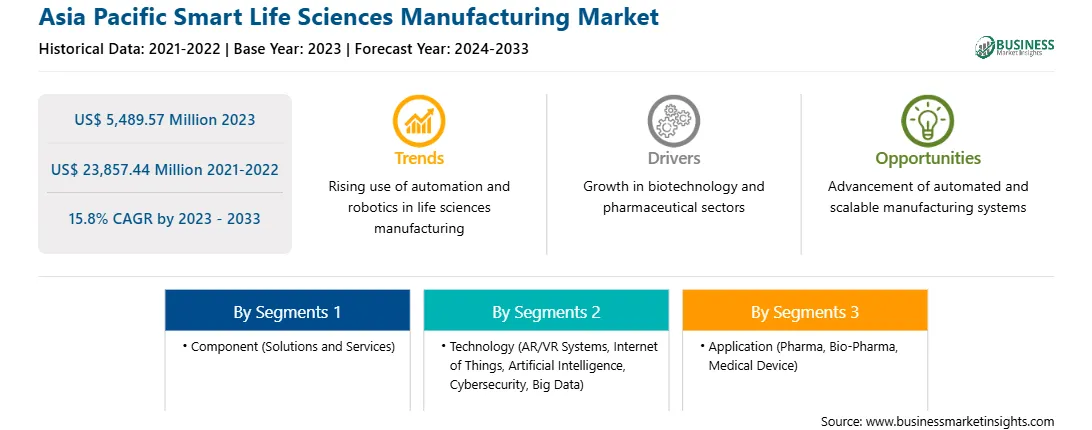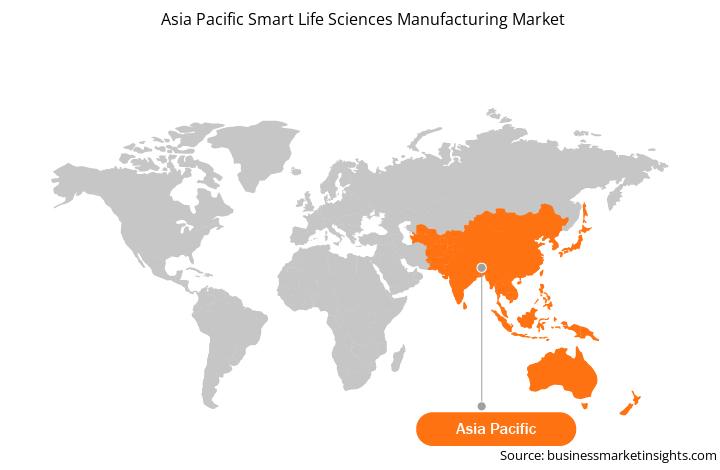Asia Pacific Smart Life Sciences Manufacturing Market
No. of Pages: 196 | Report Code: BMIRE00028921 | Category: Technology, Media and Telecommunications
No. of Pages: 196 | Report Code: BMIRE00028921 | Category: Technology, Media and Telecommunications
A data silo is a storehouse of data that is separated from the rest of the organization and these repositories are mostly controlled by one department. Different reasons can drive the formation of data silos; a few of these include improper management, time-consuming stuff, inferior infrastructure, inter-department competition, and variable data sources. The concerned departments may make a data silo to protect patient’s health information, in accordance with government regulations surrounding data privacy and security. The present volume of medical data is too big, and it is growing at a faster rate than before. Traditional software techniques are not sufficient to process these data. However, companies that have big data or machine learning tools may benefit from such huge volumes of medical data. Further, big data analytics can process both structured and unstructured data to convert it into meaningful information.
The connection of data silos is increasing, which is likely to result in better access to insights and data leads, eventually supporting creative research. Large data allows more efficient data research and accelerates the innovation process. Technologies such as blockchain and AI will help to break the isolated data silos. Blockchain technology can provide a visible and secure way to exchange data within and among research organizations and pharmaceutical companies. AI collects and analyzes vast volumes of data obtained from different sources in different formats, filtering relevant insights from noise and providing an understanding of the context.
Asia Pacific is one of the fastest developing regions. The Asia Pacific smart life sciences manufacturing market is segmented into China, Japan, India, Australia, South Korea, and the Rest of Asia Pacific. The presence of rapidly growing countries is likely to create ample opportunities for smart life sciences manufacturers in the coming years. The developing healthcare industry; rising collaborations among market players; and increasing implementation of advanced technologies such as artificial intelligence, augmented reality, virtual reality, big data analytics, and others by manufacturers are expected to drive the market growth in the coming years. In 2022, the Singapore Government launched Biologics Pharma Innovation Programme Singapore (BioPIPS) to increase the country’s manufacturing capacity for biologics, including recombinant proteins and vaccines. GSK, Sanofi, and Takeda have joined the BioPIPS project alongside the National University of Singapore, Nanyang Technological University, and the Singapore Institute of Technology (SIT). Sanofi is building a next-generation manufacturing site, the Evolutive Facility, in Singapore, which will bring advanced digital and modular vaccine production capabilities to Asia.
Strategic insights for the Asia Pacific Smart Life Sciences Manufacturing provides data-driven analysis of the industry landscape, including current trends, key players, and regional nuances. These insights offer actionable recommendations, enabling readers to differentiate themselves from competitors by identifying untapped segments or developing unique value propositions. Leveraging data analytics, these insights help industry players anticipate the market shifts, whether investors, manufacturers, or other stakeholders. A future-oriented perspective is essential, helping stakeholders anticipate market shifts and position themselves for long-term success in this dynamic region. Ultimately, effective strategic insights empower readers to make informed decisions that drive profitability and achieve their business objectives within the market. The geographic scope of the Asia Pacific Smart Life Sciences Manufacturing refers to the specific areas in which a business operates and competes. Understanding local distinctions, such as diverse consumer preferences (e.g., demand for specific plug types or battery backup durations), varying economic conditions, and regulatory environments, is crucial for tailoring strategies to specific markets. Businesses can expand their reach by identifying underserved areas or adapting their offerings to meet local demands. A clear market focus allows for more effective resource allocation, targeted marketing campaigns, and better positioning against local competitors, ultimately driving growth in those targeted areas.Asia Pacific Smart Life Sciences Manufacturing Strategic Insights

Asia Pacific Smart Life Sciences Manufacturing Report Scope
Report Attribute
Details
Market size in 2023
US$ 5,489.57 Million
Market Size by 2033
US$ 23,857.44 Million
Global CAGR (2023 - 2033)
15.8%
Historical Data
2021-2022
Forecast period
2024-2033
Segments Covered
By Component
By Technology
By Application
Regions and Countries Covered
Asia-Pacific
Market leaders and key company profiles
Asia Pacific Smart Life Sciences Manufacturing Regional Insights

Asia Pacific Smart Life Sciences Manufacturing Market Segmentation
The Asia Pacific smart life sciences manufacturing market is segmented into technology, component, application, and country.
Based on component, the Asia Pacific smart life sciences manufacturing market is segmented into solutions and services. The solution segment held a larger share of the Asia Pacific smart life sciences manufacturing market in 2023.
Based on technology, the Asia Pacific smart life sciences manufacturing market is categorized into AR/VR Systems, IoT, AI, Cybersecurity, Big Data, and others. Further, by technology, the cybersecurity segment is sub-segmented into IT cybersecurity and OT cybersecurity. In 2023, the OT cybersecurity sub-segment held a larger market share.
Based on application, the Asia Pacific smart life sciences manufacturing market is segmented into pharma, bio-pharma, and medical devices. The medical devices segment held the largest share of the Asia Pacific smart life sciences manufacturing market in 2023.
Based on country, the Asia Pacific smart life sciences manufacturing market is segmented into Australia, China, India, Japan, South Korea, and the Rest of Asia Pacific. China dominated the Asia Pacific smart life sciences manufacturing market in 2023.
ABB Ltd, Bosch Rexroth AG, Emerson Electric Co, Fortinet Inc, General Electric Co, Honeywell International Inc, International Business Machines Corp, Rockwell Automation Inc, Siemens AG, and Sophos Ltd are some of the leading companies operating in the Asia Pacific smart life sciences manufacturing market.
The Asia Pacific Smart Life Sciences Manufacturing Market is valued at US$ 5,489.57 Million in 2023, it is projected to reach US$ 23,857.44 Million by 2033.
As per our report Asia Pacific Smart Life Sciences Manufacturing Market, the market size is valued at US$ 5,489.57 Million in 2023, projecting it to reach US$ 23,857.44 Million by 2033. This translates to a CAGR of approximately 15.8% during the forecast period.
The Asia Pacific Smart Life Sciences Manufacturing Market report typically cover these key segments-
The historic period, base year, and forecast period can vary slightly depending on the specific market research report. However, for the Asia Pacific Smart Life Sciences Manufacturing Market report:
The Asia Pacific Smart Life Sciences Manufacturing Market is populated by several key players, each contributing to its growth and innovation. Some of the major players include:
The Asia Pacific Smart Life Sciences Manufacturing Market report is valuable for diverse stakeholders, including:
Essentially, anyone involved in or considering involvement in the Asia Pacific Smart Life Sciences Manufacturing Market value chain can benefit from the information contained in a comprehensive market report.